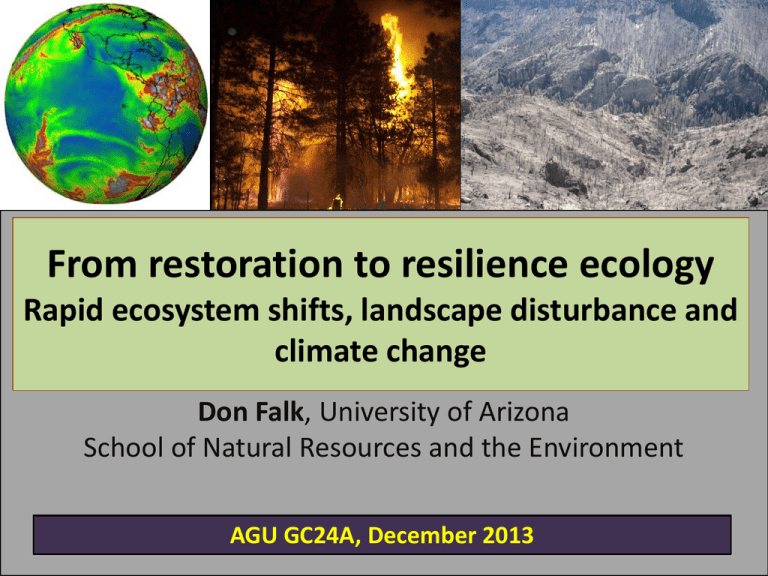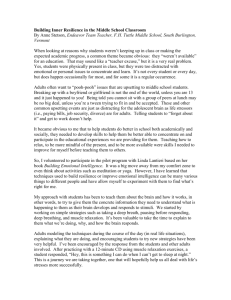From restoration to resilience ecology Rapid ecosystem shifts, landscape disturbance and
advertisement

From restoration to resilience ecology Rapid ecosystem shifts, landscape disturbance and climate change Don Falk, University of Arizona School of Natural Resources and the Environment AGU GC24A, December 2013 Ecological change driven by climate alone operates on decadal time scales • Poleward migration ~10 – 80 (160) km century-1 • Upslope movement ~ 60 – 100 m century-1 Parmesan and Yohe 2003; Chen et al. 2011; Notaro et al. 2012 In contrast, severe large-scale disturbances can trigger abrupt ecological change with more unpredictable outcomes than climate alone Giant pyrovortex, 2011 Las Conchas Fire: Craig Allen, USGS. Jemez Mts fire severity composite: Andi Thode, NAU. (How) will ecosystems recover after severe disturbance, and what can and should managers do? 1. Recover quickly to pre-fire condition (“resilient”). 2. Recover slowly (decades, centuries) to pre-fire condition. 3. Become entrained in a new state (e.g. shrub-dominated, chaparral; “tipping point” type conversion) Deconstructing “resilience” Hobbs and Suding 2009 “The capacity of an ecosystem to recover to its pre-disturbance composition, structure, and/or function over time.” • Note the similarity to SER’s definition of “restoration” • Implicitly n-dimensional (i.e., multiple response variables), scale dependent Unpacking “scaled resilience” 1. Spatial scale of disturbance and response E.g. small forest patches cf. entire watersheds 2. Time scale of response We assume “rapid” (sic) responses (1-2 yr) indicate resilient behavior, whereas slower response times (>100 yr) do not – is this true? 3. Level of biological organization (IPSCE) We associate “resilient” behavior with getting back the same species; alternative metastable states are judged “novel” or type-converted Case 1: Rapid, small scale disruption, rapid recovery, individuals survive (“resilient”) 4 3 2 1 0 1 1 10 10 100 100 1000 BIOLOGICAL LEVEL 5 Landscape reburns in the Chiricahua Mountains, a Madrean “Sky Island” Nested sequences of fire severity (U,L,M,H) in 2 events Chiricahua maps and images: Jesse Minor, U.Arizona Pre-fire Fuel models, Chiricahua Mountains Figures courtesy C. Stetson, Coronado NF and D. Helmbrecht, USFS TEAMS Post-fire Fuel models, Chiricahua Mountains Figures courtesy C. Stetson, Coronado NF and D. Helmbrecht, USFS TEAMS Catalina Mts, 2013 (Photo: Jim Malusa) Catalina Mts, 1912 (Photo: Forrest Shreve) Case 2: Larger scale disruption, decadal recovery, some turnover in species 1 1 10 10 100 100 1000 Near-total overstory tree mortality at watershed scale, 2011 Las Conchas Fire, Jemez Mountains, NM Following mortality events, species persistence is dependent on recruitment, but climate trajectories may preclude conditions Max growing season temp Persistence E1 E0 R Min growing season soil water potential Colwell and Rangel 2009 Case 3: Large scale disruption, multi-decadal response, change in community (type conversion) 5 4 3 2 1 0 1 1 10 10 100 100 1000 Brock and Carpenter 2010; Scheffer et al. 2012 Conclusions 1.Resilience can be decomposed into component scales and biological levels. 2.Post-disturbance ecological trajectories are contingent on climate space, landscape structure, soils, and disturbance regimes. 3.Restoration is a means of expanding the resilience space in which ecosystems recover in rapidly changing environments. Post-fire aspen patches, Sangre de Cristo Mountains, NM: Ellis Margolis, University of Arizona Thanks: Craig Allen, USGS Cal Farris, NPS Rachel Loehman, Connie Millar, Don McKenzie, USFS Research Lauren Maghran, Ellis Margolis, Jim Malusa, Jesse Minor, Tom Swetnam, University of Arizona Bob Parmenter, Valles Caldera National Preserve Chris Stetson, Craig Wilcox, Coronado National Forest Andrea Thode, Northern Arizona University








